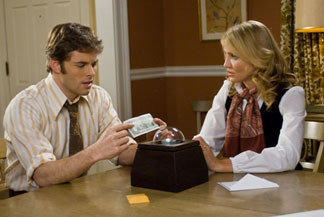Book vs. Movie: The Box
By Russ Bickerstaff
November 9, 2009
The brilliantly effective thing about the TV adaptation is its clever use of dramatic ambiguity. The story is resolved without ever REALLY being resolved because the creepy poetry of the premise has played across the screen. There's no telling what's going to happen next and here we have even less of an idea of who Mr. Seward is, who he represents and why on earth he's doing what he's doing. It's brilliantly sinister. But Richard Matheson didn't like it.
Matheson, who wrote the original short story AND the teleplay, didn't like the direction Medak took with it and took his name off the script. He didn't like the ending. In his introduction to the 1991 print compilation New Stories from the Twilight Zone, fellow Twilight Zone author Alan Brennert agreed with Matheson, lumping the TV adaptation of Button, Button in with a few others that he felt were, "good scripts mauled by bad directors, bad production, bad acting or all three." Brennert and Matheson are as entitled to their opinions as anybody, but I feel the ending to the print version lacked the kind of eerie finesse and delicious ambiguity of the TV version. It remains one of the most memorable stories from the first season of the 86-87 Twilight Zones. It's pretty rare when major network television effectively renders subtle ambiguity. This might've been one of the few times it had ever really been attempted in the '80s.
The Movie
Produced over two decades after the TV adaptation, the film sets the story in the rather narrow confines of Virginia in December of 1976. It's a retro contemporary style that's executed pretty well. James Marsden and Cameron Diaz play Arthur and Norma as a solidly upper middle class couple. He works at NASA. She's a schoolteacher. They have a son. It's all very quaint. The film wastes little time in setting up the plot. Arthur and Norma are in bed when they hear someone at the door of their relatively spacious home. She goes down to answer the door only to see a car driving away. A carton rests at the foot of the door. She brings it in. He opens it as she and their son have breakfast.
The prop itself is actually quite classy looking. The button rests underneath a glass dome on an anodized aluminum plate on the top of a wooden box. It looks far slicker than its TV counterpart. The card that accompanies the button unit announcing Mr. Seward's imminent arrival is a large, wedding invitation-style affair with calligraphy and such. Mr Seward arrives — played here by Frank Langella. We find out in an opening bit of text that he had been struck by lightning, resulting in a rather nasty burn that is nonetheless very, very artificial-looking. The offer is more or less the same as it has been in previous incarnations of the story — except that the monetary reward in THIS particular adaptation ends up being $1 million — quite a bit in 1976. And it's kind of necessary here. With the family being solidly upper middle class, the money in question would HAVE to be more. Still, it loses something. We're bearing witness to the concerns of a family that isn't really struggling. Yes, she says they're living paycheck to paycheck, but they're both working decent jobs and living in a nice house. Money doesn't feel like as big a concern here as it is in the TV version.
Continued:
1
2
3
4
5




